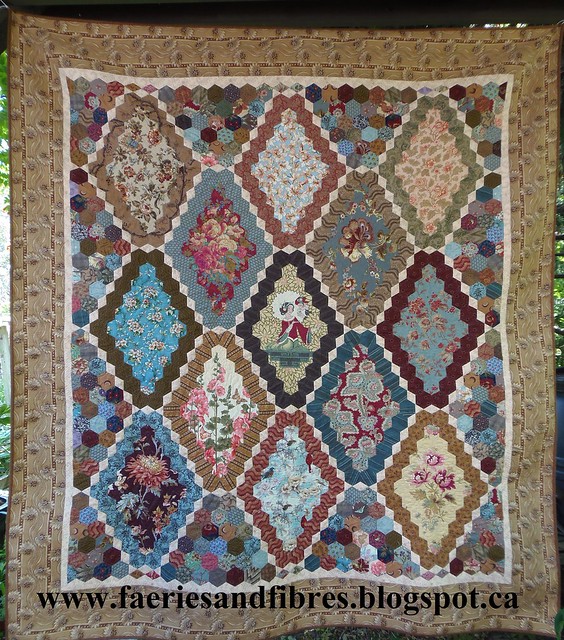I'm so pleased to hear from so many of you that you enjoyed the tutorial on my open donut method of constructing hexagon rosettes. I had written about it many times but finally decided to write a post with detailed photographs. I used this same method to construct the ring of hexagons that surrounds the medallion in my Birds in The Loft hexagon quilt. I made a large open donut of the rosettes (it looked like a long noodle).
It was then stitched to the medallion in the same way that I stitched a rosette. As each hexagon is surrounded by others the paper is removed; it reduces the bulk and makes the manipulation of the fabric and the sewing so much easier (and faster).
When I was making my hexagon quilt Lozagons I used the open donut method to construct the multi-round rosettes. I made the centre rosette and then made open donuts for the remaining round. I tacked them together with needle and thread until I was ready to sew them together.
I made a pile of blocks, tacked the pieces together and stored them in a pretty box. Everything is kept together and there are no lost pieces!
I've completed five more pairs of hexagon rosettes for my Birds in the Loft quilt. Here they are!
Both of these fabrics have been in my stash for some time now so it was time to start chopping them up!
I used the leftover green bits for the centre hexagon in this rosette.
I used the outer turquoise in my Gardens of a King quilt top and the centre fabric is a treasured scrap. There isn't much left and the selvage is long gone. I wish I had more of it!
The centre hexagon is another leftover from another rosette. It was the outer ring of the rosette but in this block it is the centre hexagon. Repeating your scraps in this way is a terrific way to make your scrap quilt more cohesive!
That's all for today! I've got more sewing to do if I'm going to keep you entertained and get this quilt top finished so until I post again, happy sewing!
Karen H





















































